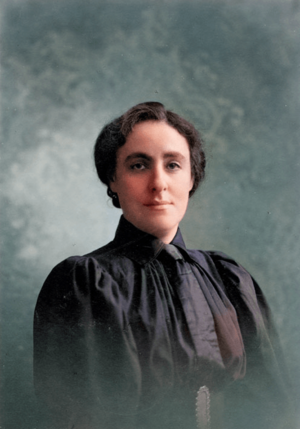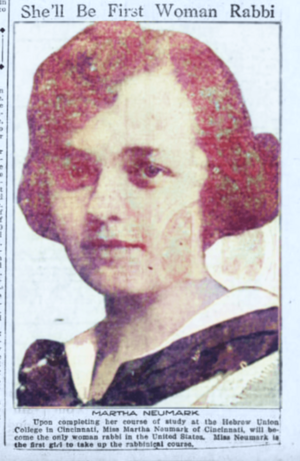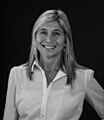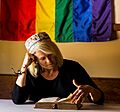Timeline of women rabbis in the United States facts for kids
This article is about the history of women rabbis in the United States. For a general article on this topic, see Women rabbis and Torah scholars.
A rabbi is a spiritual leader and teacher in Judaism. For a long time, only men could become rabbis. But over the years, many brave and dedicated women have broken barriers to become rabbis in the United States. This timeline shows some of their important achievements.
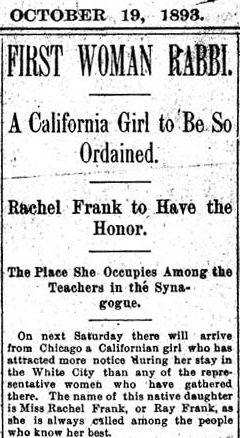
Article from the San Francisco Chronicle on October 19, 1898, announcing Ray Frank as a female rabbi
Contents
Early Women in Jewish Leadership
Pioneering Voices
- 1890s: Ray Frank was a young Jewish woman who lived in the American West. She started giving sermons, which are religious speeches, in her small Jewish community. Many people at the time called her the "first woman rabbi."
First Formal Ordinations
- 1972: Sally Priesand made history by becoming the first female rabbi ordained, or officially recognized, by a rabbinical seminary in America. She was the second woman in Jewish history to be formally ordained as a rabbi, after Regina Jonas.
- 1974: Sandy Eisenberg Sasso became the first female rabbi in Reconstructionist Judaism, a branch of Judaism.
- 1975: The Women's Rabbinic Network was started. This is a national group for female Reform rabbis in America. It was founded by women who were studying to become rabbis.
- 1976: Michal Mendelsohn became the first woman to lead a congregation, or a group of worshippers, in North America. She was hired by Temple Beth El Shalom in San Jose, California.
- 1976: Rabbi Ilene Schneider was one of the first six women to be ordained as rabbis in the United States. She graduated from the Reconstructionist Rabbinical College.
- 1977: Sandy Eisenberg Sasso and her husband, Dennis Sasso, became the first married couple to serve as rabbis together. They worked at Beth-El Zedeck in Indianapolis.
- 1979: Linda Joy Holtzman became the first woman to serve as a rabbi for a Conservative congregation. She was hired by Beth Israel Congregation of Chester County. Even though she graduated from the Reconstructionist Rabbinical College, a Conservative congregation hired her.
Expanding Roles for Women Rabbis
New Fields and Communities
- 1981: Helene Ferris became the first woman to become a rabbi as a second career. This means she had another job before becoming a rabbi.
- 1981: Lynn Gottlieb became the first female rabbi in Jewish Renewal, another Jewish movement.
- 1981: Bonnie Koppell was the first female rabbi to serve in the U.S. military. She joined the army reserves while she was still studying to become a rabbi and was ordained in 1981.
- 1984: Barbara Borts, who was born in America, became the first woman rabbi to have her own pulpit, or a leading position, in a UK Reform Judaism synagogue. She served there from 1984 to 1990.
- 1985: Amy Eilberg became the first female rabbi in Conservative Judaism.
- 1986: Amy Perlin was the first female rabbi in America to start her own congregation. She founded Temple B'nai Shalom in Fairfax Station.
- 1986: Leslie Alexander became the first female rabbi of a major Conservative Jewish synagogue in the United States. This happened at Adat Ari El synagogue in North Hollywood.
- 1986: Julie Schwartz became the first woman to serve as an active-duty Jewish chaplain in the U.S. Navy. A chaplain is a religious leader who serves in the military.
- 1987: Joy Levitt became the first female president of the Reconstructionist Rabbinical Association.
- 1992: Karen Soria was the first female rabbi to serve in the U.S. Marines. She served from 1992 to 1996.
- 1993: Rebecca Dubowe became the first Deaf woman to be ordained as a rabbi in the United States.
- 1993: Ariel Stone became the first American rabbi to lead a congregation in the former Soviet Union. She was also the first progressive rabbi to serve the Jewish community in Ukraine.
- 1993: Chana Timoner became the first female rabbi to have an active-duty job as a chaplain in the U.S. Army.
- 1994: Laura Geller became the first woman to lead a major city congregation. This was Temple Emanuel in Beverly Hills.
- 1994: Rabbi Shohama Wiener became the first woman to lead a Jewish seminary, which is a school for training religious leaders. She led the Academy for Jewish Religion.
- 1995: Dianne Cohler-Esses became the first Syrian woman to become a rabbi. She was also the first Syrian non-Orthodox rabbi. She was ordained by the Jewish Theological Seminary.
- 1996: Cynthia Culpeper became the first rabbi serving in a congregation to announce she had been diagnosed with AIDS. She was the rabbi of Agudath Israel Etz Ahayem in Montgomery, Alabama.
- 1999: Tamara Kolton became the very first rabbi in Humanistic Judaism, a different branch of Judaism.
- 2000: Helga Newmark, who was born in Germany, became the first female Holocaust survivor to be ordained as a rabbi. She was ordained in America.
Diverse Voices and Leadership
Breaking More Barriers
- 2001: Angela Warnick Buchdahl, who was born in Korea, became the first Asian-American rabbi. She was ordained in America.
- 2002: Jacqueline Mates-Muchin was ordained by Hebrew Union College-Jewish Institute of Religion in New York. This made her the first Chinese-American rabbi.
- 2002: Pamela Frydman became the first female president of OHALAH, which is an association of rabbis for Jewish Renewal.
- 2003: Janet Marder was named the first female president of the Reform Movement's Central Conference of American Rabbis (CCAR). This made her the first woman to lead a major rabbinical organization. She was also the first woman to lead any major Jewish religious organization in the United States that included both men and women.
- 2003: Sarah Schechter became the first female rabbi to serve as a chaplain in the U.S. Air Force.
- 2008: Julie Schonfeld was named the new executive vice president of the Conservative movement's Rabbinical Assembly. This made her the first female rabbi to hold the top leadership position of an American rabbinical association.
- 2009: Avi Weiss ordained Sara Hurwitz with the title "maharat." This title is an acronym for "manhiga hilkhatit rukhanit Toranit," which means a leader in Jewish law and spirituality. Later, Weiss changed the title to "Rabba." Hurwitz continues to use the title Rabba and is seen by some as the first female Orthodox rabbi.
- 2009: Alysa Stanton, born in Cleveland, became the first African-American female rabbi. She was ordained by a Reform Jewish seminary. Later in 2009, she started working as a rabbi at Congregation Bayt Shalom in Greenville, North Carolina. This made her the first African-American rabbi to lead a congregation where most members were white.
- 2012: Ilana Mills, Jordana Chernow-Reader, and Mari Chernow became the first three sisters in America to all become rabbis.
- 2014: Rabbi Deborah Waxman became the president of the Reconstructionist Rabbinical College and Jewish Reconstructionist Communities. This college is both a group of congregations and a seminary.
- 2015: Mira Rivera became the first Filipino-American woman to be ordained as a rabbi.
- 2015: Lila Kagedan, born in Canada, became the first graduate of Yeshivat Maharat to use the title "Rabbi."
- 2016: After much discussion, Hebrew Union College-Jewish Institute of Religion decided to give women a choice of wording on their ordination certificates starting in 2016. This included the option to have the same wording as men. Before this, men's certificates used a traditional term meaning "our teacher the rabbi," while women's certificates used a different term meaning "rabbi and teacher."
Images for kids
-
Rabbi Alysa Stanton

All content from Kiddle encyclopedia articles (including the article images and facts) can be freely used under Attribution-ShareAlike license, unless stated otherwise. Cite this article:
Timeline of women rabbis in the United States Facts for Kids. Kiddle Encyclopedia.

